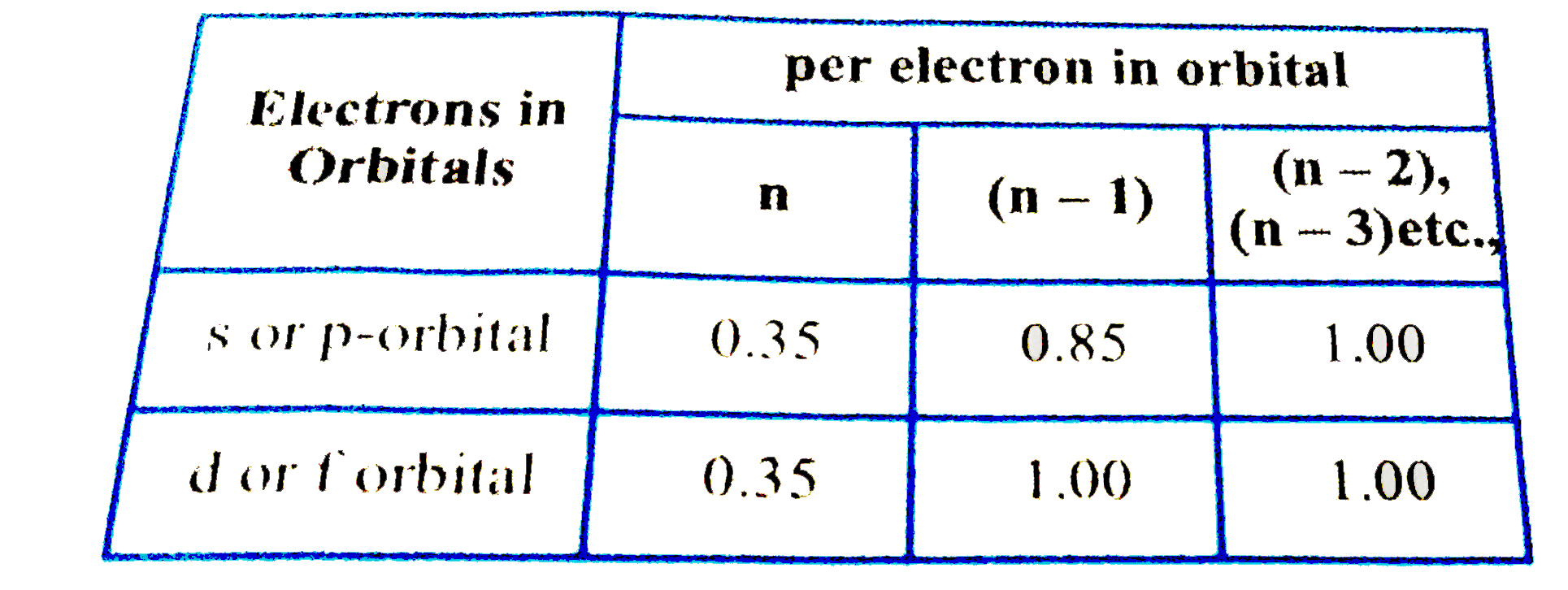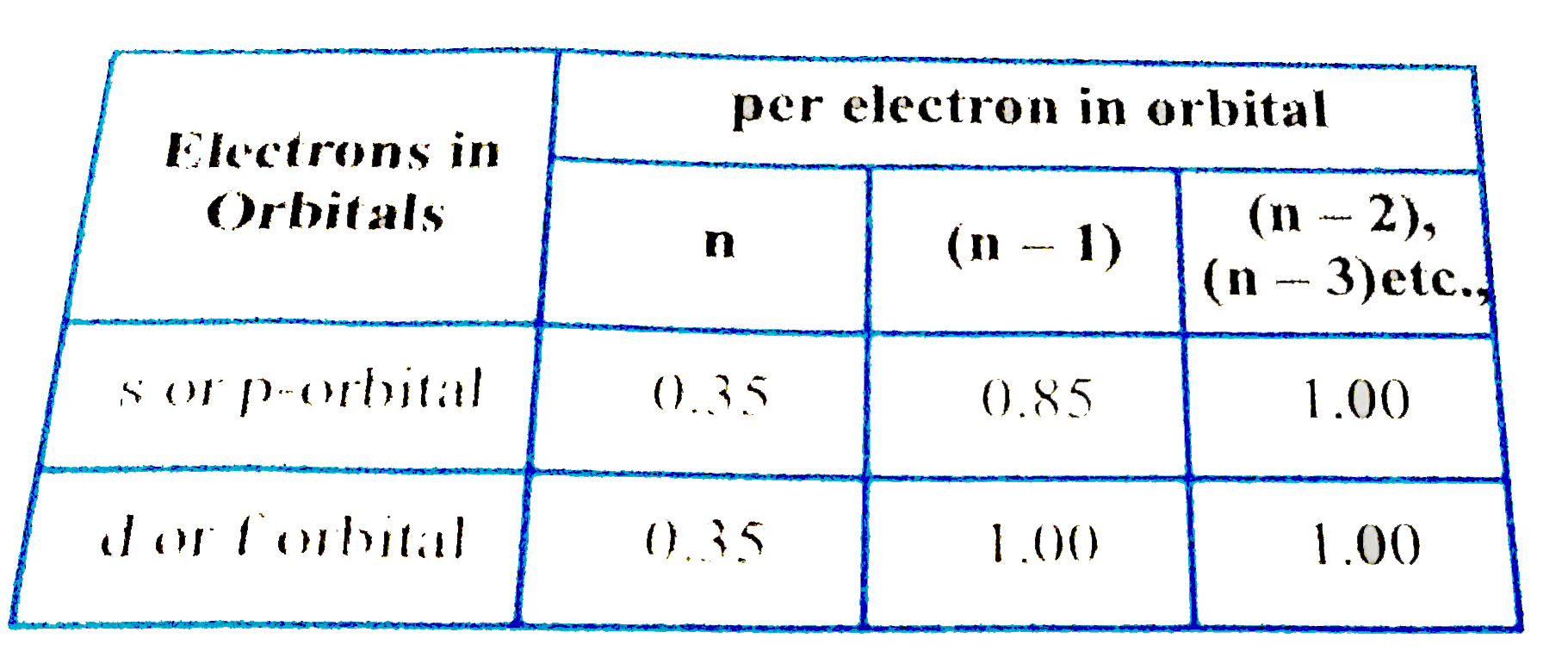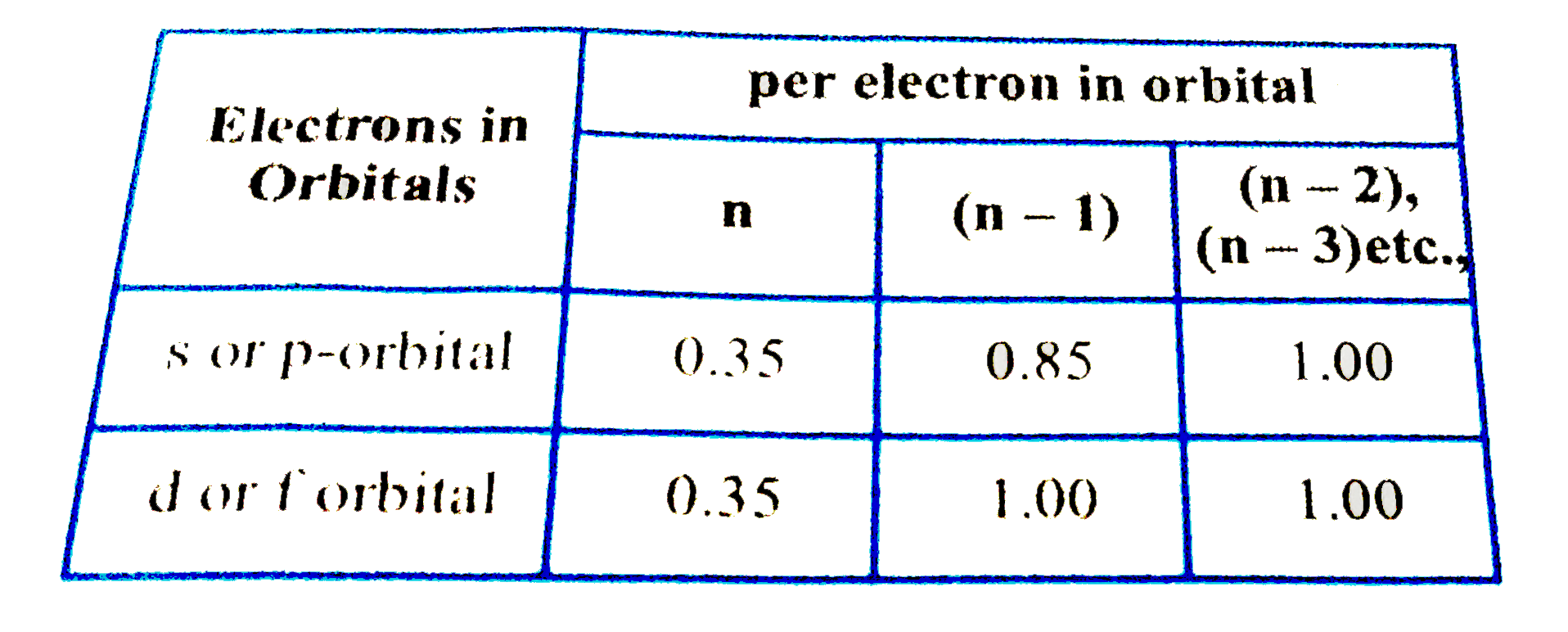Nuclear charge actually experienced by an electron is termed as effective nuclear charge The effective nuclear Z∗ actually depends on type of shell and orbital in which electron is actually present. The relative extent to which the various orbitals penetrate is .s>p>d>f (for the same value of n)
The phenomenon in which penulitmate shell electrons act as screen or shield in between nucleus adn valence shell electrons and there by reducing nuclear charge is known as sheilding effect. The penultimate shell electrons repel the valence shell electron to keep them loosely held with nucleus . It is thus evident that more is the shielding effect, lesser is the effective nuclear charge and lesser is the ionizatio energy.
Ionization energy is not influenced by :
size of atom
Effective nuclear charge
Electron present in inner shell
Change in entropy
The correct Answer is:D
Step by step video, text & image solution for Nuclear charge actually experienced by an electron is termed as effective nuclear charge The effective nuclear Z^(**) actually depends on type of shell and orbital in which electron is actually present. The relative extent to which the various orbitals penetrate is .s gt p gt d gt f (for the same value of n) The phenomenon in which penulitmate shell electrons act as screen or shield in between nucleus adn valence shell electrons and there by reducing nuclear charge is known as sheilding effect. The penultimate shell electrons repel the valence shell electron to keep them loosely held with nucleus . It is thus evident that more is the shielding effect, lesser is the effective nuclear charge and lesser is the ionizatio energy. Ionization energy is not influenced by : by Chemistry experts to help you in doubts & scoring excellent marks in Class 12 exams.
Topper's Solved these Questions
Similar Questions
The final products is the following sequenceof reaction is
 06:04View Solution
06:04View SolutionWhich of the following polymers of glucose is stored by animals?
06:04View SolutionNuclear charge actually experienced by an electron is termed as effective nuclear charge The effective nuclear Z∗ actually depends on type of shell and orbital in which electron is actually present. The relative extent to which the various orbitals penetrate is .s>p>d>f (for the same value of n)
The phenomenon in which penulitmate shell electrons act as screen or shield in between nucleus adn valence shell electrons and there by reducing nuclear charge is known as sheilding effect. The penultimate shell electrons repel the valence shell electron to keep them loosely held with nucleus . It is thus evident that more is the shielding effect, lesser is the effective nuclear charge and lesser is the ionizatio energy.
Which of the following is not concerned to effective nuclear charge?01:51View SolutionNuclear charge actually experienced by an electron is termed as effective nuclear charge The effective nuclear Z∗ actually depends on type of shell and orbital in which electron is actually present. The relative extent to which the various orbitals penetrate is .s>p>d>f (for the same value of n)
The phenomenon in which penulitmate shell electrons act as screen or shield in between nucleus adn valence shell electrons and there by reducing nuclear charge is known as sheilding effect. The penultimate shell electrons repel the valence shell electron to keep them loosely held with nucleus . It is thus evident that more is the shielding effect, lesser is the effective nuclear charge and lesser is the ionizatio energy.
Ionization energy is not influenced by :01:51View SolutionAccording to I.C slater effective nuclear charge, Z∗, due to screening, is not exactly equal to the actual nuclear charge Z of the nucleus of the atom. Z∗ depends on the type of orbitals in which the electron is housed, and on the ability of other electrons in more penetrating orbitals to screen the electron in question from the nucleus.
The relative extent to which the various orbitals penetrate the electron clouds of other orbitals is s>p>f . The effective nuclear charge Z∗ due to screening is given by Z∗=Z−σ, where Z is the atomic atomic number and σ is the slater screening constant values 0<σ<Z

Screening effect of one electron in the outermost orbitals, is not considered in calculate of σ.
What is the value of Z∗ for Rb(37) ?01:29View SolutionAccording to I.C slater effective nuclear charge, Z∗, due to screening, is not exactly equal to the actual nuclear charge Z of the nucleus of the atom. Z∗ depends on the type of orbitals in which the electron is housed, and on the ability of other electrons in more penetrating orbitals to screen the electron in question from the nucleus.
The relative extent to which the various orbitals penetrate the electron clouds of other orbitals is s>p>f . The effective nuclear charge Z∗ due to screening is given by Z∗=Z−σ, where Z is the atomic atomic number and σ is the slater screening constant values 0<σ<Z

Screening effect of one electron in the outermost orbitals, is not considered in calculate of σ.
what is Z∗ for Cu(29) ?01:56View SolutionNuclear charge actually experienced by an electron is termed as effective nuclear charge The effective nuclear Z^(**) actually depends on type of shell and orbital in which electron is actually present. The relative extent to which the various orbitals penetrate is . s gt p gt d gt f (for the same value of n) The phenomenon in which penulitmate shell electrons act as screen or shield in between nucleus adn valence shell electrons and there by reducing nuclear charge is known as sheilding effect. The penultimate shell electrons repel the valence shell electron to keep them loosely held with nucleus . It is thus evident that more is the shielding effect, lesser is the effective nuclear charge and lesser is the ionizatio energy. In which of the following valence electron experience maximum effective nuclear charge?
02:25View SolutionAccording to I.C slater effective nuclear charge, Z^(**) , due to screening, is not exactly equal to the actual nuclear charge Z of the nucleus of the atom. Z^(**) depends on the type of orbitals in which the electron is housed, and on the ability of other electrons in more penetrating orbitals to screen the electron in question from the nucleus. The relative extent to which the various orbitals penetrate the electron clouds of other orbitals is s gt p gt f . The effective nuclear charge Z^(**) due to screening is given by Z^(**)=Z-sigma , where Z is the atomic atomic number and sigma is the slater screening constant values 0 lt sigma lt Z Screening effect of one electron in the outermost orbitals, is not considered in calculate of sigma . What is the value of Z^(**) for Rb(37) ?
06:26View SolutionAccording to I.C slater effective nuclear charge, Z∗, due to screening, is not exactly equal to the actual nuclear charge Z of the nucleus of the atom. Z∗ depends on the type of orbitals in which the electron is housed, and on the ability of other electrons in more penetrating orbitals to screen the electron in question from the nucleus.
The relative extent to which the various orbitals penetrate the electron clouds of other orbitals is s>p>f . The effective nuclear charge Z∗ due to screening is given by Z∗=Z−σ, where Z is the atomic atomic number and σ is the slater screening constant values 0<σ<Z

Screening effect of one electron in the outermost orbitals, is not considered in calculate of σ.
In which of the following cases the concept of Z∗ is applicable?03:07View SolutionNuclear charge actually experienced by an electron is termed as effective nuclear charge. The effective nuclear charge Z∗ actuall ydepends on type of shell and orbital in which electron is actually present. The relative extent to which the various orbitals penetrate the electron clouds of other orbitals is
s>p>d>f (for the same value of n)
The phenomenon in which penultimate shell electrons act as screen or sheild in between nucleus and valence shell electrons and thereby reducing nuclear charge is known as shielding effect. the penultimate shell electrons repel the valence shell electron to keep them loosely held with nucleus. it is thus evident that more is the shielding effect, lesser is the effective nuclear charge and lesser is the ionization energy.
Q. Which of the following valence electron experience maximum effective nuclear charge?View SolutionNuclear charge actually experienced by an electron is termed as effective nuclear charge. The effective nuclear charge Z∗ actuall ydepends on type of shell and orbital in which electron is actually present. The relative extent to which the various orbitals penetrate the electron clouds of other orbitals is
s>p>d>f (for the same value of n)
The phenomenon in which penultimate shell electrons act as screen or sheild in between nucleus and valence shell electrons and thereby reducing nuclear charge is known as shielding effect. the penultimate shell electrons repel the valence shell electron to keep them loosely held with nucleus. it is thus evident that more is the shielding effect, lesser is the effective nuclear charge and lesser is the ionization energy.
Q. Ionzation enegy is not influenced by:View SolutionNuclear charge actually experienced by an electron is termed as effective nuclear charge. The effective nuclear charge Z^(**) actuall ydepends on type of shell and orbital in which electron is actually present. The relative extent to which the various orbitals penetrate the electron clouds of other orbitals is s gt p gt d gt f (for the same value of n) The phenomenon in which penultimate shell electrons act as screen or sheild in between nucleus and valence shell electrons and thereby reducing nuclear charge is known as shielding effect. the penultimate shell electrons repel the valence shell electron to keep them loosely held with nucleus. it is thus evident that more is the shielding effect, lesser is the effective nuclear charge and lesser is the ionization energy. Q. Which of the following valence electron experience maximum effective nuclear charge?
View SolutionNuclear charge actually experienced by an electron is termed as effective nuclear charge. The effective nuclear charge Z∗ actuall ydepends on type of shell and orbital in which electron is actually present. The relative extent to which the various orbitals penetrate the electron clouds of other orbitals is
s>p>d>f (for the same value of n)
The phenomenon in which penultimate shell electrons act as screen or sheild in between nucleus and valence shell electrons and thereby reducing nuclear charge is known as shielding effect. the penultimate shell electrons repel the valence shell electron to keep them loosely held with nucleus. it is thus evident that more is the shielding effect, lesser is the effective nuclear charge and lesser is the ionization energy.
Q. Which of the following is not concerned to effective nuclear charge?01:19:56View SolutionNuclear charge actually experienced by an electron is termed as effective nuclear charge. The effective nuclear charge Z∗ actuall ydepends on type of shell and orbital in which electron is actually present. The relative extent to which the various orbitals penetrate the electron clouds of other orbitals is
s>p>d>f (for the same value of n)
The phenomenon in which penultimate shell electrons act as screen or sheild in between nucleus and valence shell electrons and thereby reducing nuclear charge is known as shielding effect. the penultimate shell electrons repel the valence shell electron to keep them loosely held with nucleus. it is thus evident that more is the shielding effect, lesser is the effective nuclear charge and lesser is the ionization energy.
Q. Ionzation enegy is not influenced by:01:19:56View SolutionElectron density| Penetration effect | Shielding of orbitals | Effective Nuclear Charge
03:48View SolutionElectron density| Penetration effect | Shielding of orbitals | Effective Nuclear Charge
04:33View Solution

